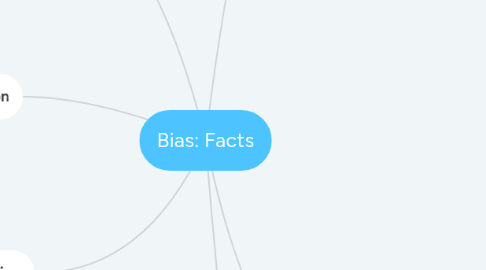
1. Democracy
1.1. In a liberal democracy, no one set group is systematically preferred over another and the information available to citizens is accurate and impartial
1.2. If the media systematically promotes some interests and misinforms citizens, the democratic process will not operate efficiently
1.3. The consequence of bias on democracy is that it sets underlying political assumptions
2. Definition
2.1. Refers to any systematic favoring of one position, but has further implications
2.2. Viewed as natural or responsible
2.3. A journalist can argue for any political cause in private, but if they were to do the same in reporting a story, this would be regarded as a dereliction of their responsibility as a reporter
3. Action
3.1. Looking for Bias
3.1.1. Establishing a method that is able to capture what is being said explicitly and implicitly
3.1.2. Provide a technique that can be used by others
3.2. Preventing Bias
3.2.1. Broadcasting: Regulatory requirements to show 'due impartiality' in their reporting of politics (BBC Guidelines)
3.2.2. Press: Legal restrains (defamation ext.) and editorial guidelines (IPSO)
4. Selective Reporting
4.1. Natural Disasters
4.1.1. 2005 reporting in UK press
4.1.2. Two hurricanes hit the American continent, both killing over 1000 people
4.1.3. Hurricane Katrina (New Orleans): mentioned 3,104 times
4.1.4. Hurricane Stanley (Guatemala): mentioned 34 times
4.2. Causes of Death
4.2.1. Swine Flu Vs. Flu
4.2.1.1. UK 2009-2010
4.2.1.2. More media attention devoted to swine flu than other strains of flu
4.2.2. Smoking Vs. Measles
4.2.2.1. Approximately 100,000 deaths a year from smoking
4.2.2.2. One story is published for every 8,571 people a year who die from smoking
4.2.2.3. Around two people die a year from measles
4.2.2.4. Four stories published about measles published a year
4.3. Women
4.3.1. John Major received more coverage than Margret Thatcher
4.3.2. Representations: Stories about women politicians refer to their looks or their families; stories about men do not
4.3.3. Women portrayed as 'path breakers' with high expectations
4.4. Coverage of other Countries (2005)
4.4.1. Travel: 25%
4.4.2. Wildlife: 21%
4.4.3. Religion/Culture/Arts: 17%
4.4.4. Conflict and Disaster: 8%
4.4.5. Politics: 3%
5. Accusation
5.1. Elections
5.1.1. UK: Parties complain about their coverage and treatment
5.1.1.1. Conservatives: did not like the way they were portrayed in TV plays about the miners' strike of 1984-5
5.1.1.2. General Election of 1987
5.1.1.2.1. TV felt obligated to give equal time to the three main parties - met what Semetko defines as 'balance'
5.1.1.2.2. Characteristic of the coverage revealed bias: the Alliance marginalized as an 'also ran' party, as they were covered on their own, while Labour and Conservative were covered locked in controversy
5.1.2. USA: Liberals and the right both feel under or misrepresented
5.2. Implication
5.2.1. Strike at the core of journalist's self-image
5.2.2. 'In-house' complaint procedures
5.2.2.1. BBC
5.2.2.2. NY Times
5.2.3. External Regulations
5.2.3.1. Ofcom is charged with ensuring that broadcasters show 'due respect for the truth'
5.2.4. 2000: South Africa's human rights commissioners demanded that 30 journalists appeared before them for accusations of racial bias
6. Bias Facts (?)
6.1. 1981 'March for Jobs'
6.1.1. A protest against the Thatcher government
6.1.2. The Sun: 5,000 protesters took part
6.1.3. Daily Star: 150,000
6.1.4. Daily Mail: 20,000
6.2. Trump's Inaurgation
6.2.1. Trump claims 1.5 million attended
6.2.2. NY Times claims only 600,000
